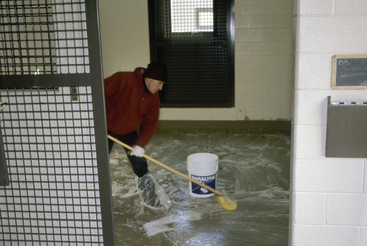CHAPTER 67 Control of Infectious Disease Outbreaks
Owners rely on veterinarians for advice on containment of infectious disease outbreaks on farms. Some of the most important pathogenic diseases of concern include salmonellosis, herpesvirus abortions, rotaviral diarrhea, and strangles. This service is most effective if offered before the outbreak of disease because appropriate preventive measures facilitate and enhance responses in the face of an outbreak.
Many recommended control measures are based on anecdotal information. First, although veterinarians are formally trained in disease prevention, especially vaccination and deworming, the typical veterinary school curriculum spends comparatively little time on instruction specifically related to equine biosecurity compared to time spent on this topic with other species. Second, because of the heterogenous nature of equine facilities, few scientific studies have evaluated the efficacy of biosecurity measures on one farm compared with other farms. As a result, recommendations for disease control on horse farms are made based on the personal experiences of the attending veterinarian, descriptions of disease control and prevention in veterinary hospitals, scientific studies in other species, and colleagues’ observations. The author has used the following methods successfully to facilitate the integration of preventive medicine and biosecurity education in equine veterinary practice
PATHOGENS
The pathogens in North America most frequently associated with disease outbreaks on equine farms are listed in Table 67-1. Method of spread, transmission, and degree of environmental contamination all contribute to the overall biocontainment plan. For example, rotavirus is the most difficult to kill with disinfectants because it is a nonenveloped virus, and thus the type of disinfection is critical to control. Salmonellosis is one of the most challenging to control environmentally because it can be highly contagious and is readily spread by fomites, avian species, and insects. Airborne viral pathogens such as influenza and herpesvirus are aerosolized, contaminating an entire barn and seeding the environment before institution of control measures is possible.
Table 67-1 Common Causes of Equine Disease Outbreaks
| PATHOGEN | DISEASE |
|---|---|
| Salmonella spp. | Acute and chronic diarrhea, septicemia, localized infections, abortion |
| Rotavirus | Diarrhea in foals |
| Influenza virus | Respiratory disease, high fever |
| Equine herpesvirus | Abortions, respiratory disease, neurologic disease |
| Equine viral arteritis | Abortions, respiratory disease |
| Streptococcus equi subsp. equi | Strangles, bastard strangles, and potentially, purpura hemorrhagica |
| Leptospira spp. | Abortions |
| Trichophyton and other fungi | Skin lesions |
Diseases of Unknown Etiology
If a foreign animal disease (FAD) is suspected, the farm should immediately (1) restrict all animal movement and (2) contact the state’s U.S. Department of Agriculture (USDA) veterinary office. A USDA veterinary medical officer (VMO) or a specialist trained in FAD detection will inspect the farm, collect data, and obtain appropriate diagnostic samples. At the time of VMO involvement, the USDA recommends and enforces quarantine measures and makes further recommendations for disease control, usually in coordination with the respective state department of health (see Chapter 68.)
FARM FACILITIES
Stalls
Where possible, stalls should ideally be constructed of nonporous materials such as painted concrete block (Fig. 67-1) or varnished or polyurethane-treated wood. Raw wood stalls cannot be thoroughly disinfected. Type of flooring is also critical for pathogen control; there is no reliable methodology for decontamination of dirt floors. Removable rubber mats can harbor infectious organisms beneath them and are difficult to remove, disinfect, and replace routinely because of their weight and size. Regardless of materials present at the time of an outbreak, a routine cleaning and disinfection plan should be prepared (Box 67-1). Raw wood stalls can be thoroughly swept, removing as much organic matter as possible. Dirt, clay, sand, and porous stall floors should be completely mucked out and wet areas sprinkled with barn lime and allowed to dry. Fans may be necessary to facilitate drying. Aisleways and tack rooms should not be neglected in yearly cleaning.
Box 67-1 Routine Stall Disinfection Procedures for Nonporous Surfaces
Modified from Dwyer RM: Horse 16:67-80, 1999.
Pest Control Plan
Insects may serve as biologic or mechanical vectors for the transmission of pathogens from one horse to another or from one area of the farm to another. Information regarding barn insect sprays, fans, and management techniques for removing standing water has been widely disseminated since the emergence of West Nile virus into North America.1




